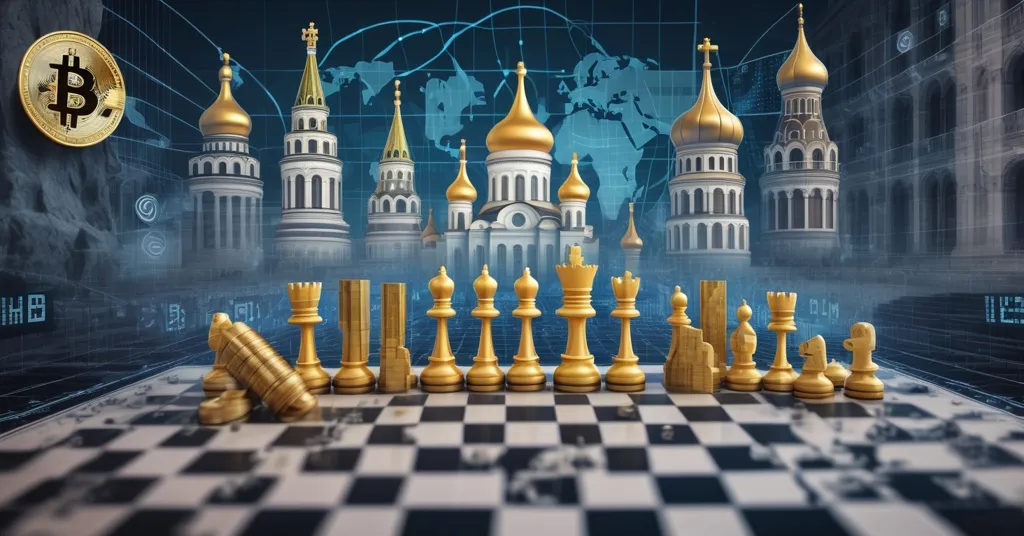Russia’s $12 Billion Crypto Trade in 2025: Sanctions Dodge or Dangerous Bet?

Russia’s $12 Billion Crypto Trade in 2025: Sanctions Evasion or Risky Gamble?
Is cryptocurrency Russia’s secret weapon against Western sanctions? In the first half of 2025, the nation shattered records by facilitating foreign trade settlements worth 1 trillion rubles—approximately $12 billion—using digital assets. Announced by Kremlin business advisor Boris Titov at the Crypto Summit 2025 in Moscow, this milestone reveals a daring bid to rewrite the rules of global finance amid unrelenting economic pressure.
- Trade Surge: Crypto settlements for foreign trade reached 1 trillion rubles ($12 billion) in H1 2025.
- Global Scale: Crypto market cap hits $4 trillion with 650 million users worldwide.
- Policy Split: International crypto use permitted experimentally; domestic payments banned.
Russia’s Crypto Trade Boom: A Financial Lifeline
The sheer scale of Russia’s crypto trade is staggering. Boris Titov, the Commissioner for the Protection of Entrepreneurs’ Rights under President Vladimir Putin, didn’t just drop numbers at the Moscow summit—he framed cryptocurrency as a cornerstone of economic survival. With a global crypto market capitalization of $4 trillion, dwarfing the economies of many European nations, and a user base of 650 million people, digital assets are no longer a niche play. They’re a heavyweight force. Titov emphasized the stabilizing effect of institutional investors, who are shifting the market away from wild retail speculation toward disciplined, long-term strategies.
“Volatility is declining, so are excess returns. But the confidence of millions of investors is growing,” Titov stated.
This isn’t just about numbers—it’s about survival. Since the 2022 invasion of Ukraine, Russia has been squeezed by Western sanctions that cut it off from global financial systems like SWIFT, a messaging network banks use to process international payments. Being excluded from SWIFT cripples a country’s ability to trade or access funds abroad. With traditional channels blocked, cryptocurrencies, which operate on decentralized ledgers called blockchains, have become a lifeline for cross-border transactions. Their borderless nature allows Russia to trade with partners without relying on Western-controlled infrastructure. For more on this massive surge, check out the detailed report on Russia’s crypto trade reaching 1 trillion rubles in 2025.
Sanctions and Decentralized Solutions: A Clever Dodge
For those new to the space, a quick primer: cryptocurrency is digital money that runs on a blockchain, a secure, decentralized record of transactions. Bitcoin, launched in 2009, pioneered this concept as a peer-to-peer currency free from banks or governments. Its appeal in Russia’s context is obvious—it enables payments without intermediaries, ideal for sidestepping sanctions. Under an “experimental legal regime” approved by the Central Bank of Russia, crypto is now used for international settlements, offering a workaround to financial isolation.
Titov envisions an even bolder future by pairing private cryptocurrencies like Bitcoin with Russia’s central bank digital currency (CBDC), the digital ruble—a government-backed digital form of the national currency. This hybrid could forge a financial system beyond the reach of Western influence.
“The combination of private crypto assets and central bank digital currencies is a historic opportunity to build a financial system independent of sanctions pressure,” Titov declared.
Imagine a small Russian exporter unable to pay suppliers due to SWIFT bans. Crypto becomes their backdoor, letting them settle deals with foreign partners—if they can navigate the regulatory hurdles. As a champion of decentralization, I see this as Bitcoin’s ethos in action: dismantling oppressive financial barriers. But let’s cut through the hype and dig into whether this is sustainable or just a flashy distraction.
Domestic Restrictions vs. Global Ambitions: A Policy Paradox
While Russia’s international crypto play makes waves, its domestic stance is a different beast. The Central Bank remains staunchly opposed to using cryptocurrencies for everyday transactions within the country. Want to buy a bowl of borscht with Bitcoin in Moscow? Forget it—that’s a non-starter. The digital ruble is the only sanctioned form of digital tender for internal use, and decentralized assets like Bitcoin or Ethereum are off-limits to most Russians. Access is restricted to “highly qualified” investors—those with significant wealth or financial expertise as defined by Russian law, leaving ordinary citizens locked out of the crypto game.
Recent laws aimed at curbing financial fraud have also indirectly clamped down on domestic crypto trading, adding more red tape. Meanwhile, the Finance Ministry, led by figures like Deputy Head Ivan Chebeskov, pushes a more progressive agenda. They advocate for wider access to digital assets and a national strategy to drive economic growth through crypto. Steps like legalizing mining, establishing a mining registry, and imposing taxes signal intent to integrate digital assets into the broader economy. Yet, the tug-of-war between the ministry’s vision and the Central Bank’s iron grip creates a fractured regulatory landscape. It’s like revving an engine while keeping the brakes slammed down—good luck getting anywhere fast.
Here’s the rub for Bitcoin purists like myself: a nation using decentralized tech to defy global sanctions while centralizing control at home feels like a betrayal of the crypto spirit. The digital ruble, currently in pilot stages, risks becoming a surveillance tool, tracking every transaction in ways Bitcoin was designed to resist. Is this financial freedom, or just state control in a shiny new wrapper?
From Mining to AI: A Surprising Tech Pivot
Beyond trade, Russia is squeezing unexpected value from its crypto infrastructure. Once a hub for energy-hungry Bitcoin mining—where powerful computers solve complex math problems to validate transactions and earn rewards—the country is now repurposing these setups for artificial intelligence (AI) and big data processing. These mining rigs, often clusters of high-powered graphics cards, are ideal for the heavy computational lifting AI demands.
“Mining has already created a large-scale infrastructure that can be repurposed for AI tasks,” Titov noted.
With the AI market projected to reach $100 billion by 2030, according to industry estimates, this shift could turn a sanctions-hit liability into a tech goldmine. Reports suggest regions like Siberia, with cheap electricity and idle mining farms, are leading this pivot. It’s a pragmatic move, positioning Russia as a dark horse in the global tech race. But let’s not get carried away—diverting hardware to AI doesn’t erase the volatility or geopolitical baggage tied to crypto’s core use here.
Risks and Realities: Playing with Fire
Let’s play devil’s advocate and face the ugly truths. Crypto as a sanctions workaround isn’t foolproof. Bitcoin’s blockchain is public—every transaction is traceable by anyone with the right tools. Western agencies like the U.S. Treasury’s Office of Foreign Assets Control (OFAC) have already targeted crypto platforms linked to Russian entities, blacklisting services like Tornado Cash for facilitating illicit funds. Privacy-focused coins like Monero offer some anonymity, but they’re a tiny fraction of the market compared to Bitcoin’s dominance. Russia’s high-stakes bet could unravel if global regulators tighten the noose.
Market risks loom large too. Even with institutional players damping volatility—Bitcoin’s price swings have dropped significantly in recent years, per volatility indices—a single shock, like a major hack or escalated conflict, could tank values overnight. And while I’m all for Bitcoin’s disruptive power, we can’t ignore that altcoins like Ethereum, with its smart contract capabilities for automated deals, or stablecoins pegged to fiat for price stability, might play niche roles in Russia’s strategy. Still, Bitcoin remains king for trade volume and ideological purity—its decentralized roots align perfectly with dodging centralized oppression.
Then there’s the domestic angle. If most Russians can’t touch crypto, how is this a revolution for the masses? It reeks of elitism, reserved for the well-connected or ultra-rich who qualify as “highly skilled” investors. The irony stings—a nation wielding decentralization globally while stifling it locally. Plus, the digital ruble’s centralized design clashes with everything Bitcoin stands for. It’s a stark reminder that tools of freedom can be weaponized for control.
Global Ripple Effects: A Geopolitical Chess Match
Russia’s crypto push doesn’t exist in a vacuum. Other sanctioned nations like Iran and Venezuela are watching closely, potentially inspired to follow suit. Allies like China, already experimenting with its own CBDC, the digital yuan, might deepen crypto trade ties with Russia, creating a parallel financial bloc outside Western dominance. But Western responses are heating up—expect more sanctions on exchanges handling Russian transactions and advanced blockchain tracing to curb evasion.
This isn’t just a financial maneuver; it’s a geopolitical chess match. Crypto is the wild card, empowering nations to challenge centralized power while exposing them to new vulnerabilities. As someone rooting for effective accelerationism, I see this as a chaotic but necessary step toward dismantling outdated financial systems. Yet, the road is riddled with landmines—regulatory whiplash, market instability, and global backlash could derail Russia’s gamble.
Key Takeaways and Questions
- What does Russia’s $12 billion crypto trade milestone mean for global finance?
It signals crypto’s rising role as a bypass for nations under sanctions, potentially reshaping international trade outside Western-controlled systems. - Why is Bitcoin likened to gold by Russian officials?
Boris Titov points to Bitcoin’s declining volatility and growing investor trust, positioning it as a stable store of value similar to gold in a digital era. - How does Russia juggle crypto innovation with domestic control?
International settlements are allowed under an experimental regime, but domestic crypto payments are banned, and access is limited to elite investors, curbing true decentralization. - Can repurposing crypto mining for AI boost Russia’s tech standing?
Redirecting mining hardware to AI and big data tasks taps into a projected $100 billion market by 2030, offering a new economic avenue amid isolation. - Is Russia’s crypto strategy a lasting answer to sanctions?
It’s an inventive dodge, but blockchain transparency, international regulatory pushback, and price volatility pose serious threats to long-term success.
Russia’s $12 billion crypto trade feat in 2025 is a bold middle finger to Western sanctions, a testament to Bitcoin’s grit, and a peek at a future where digital assets could upend global finance. Yet, it’s also a messy paradox—a nation harnessing decentralization to fight external oppression while tightening the screws at home. As we cheer blockchain’s potential to disrupt the status quo and speed up financial freedom, let’s not dodge the harsh realities. This is a high-wire act, and one misstep could send it crashing. Will decentralized tech truly outmaneuver centralized power, or is this just a fleeting mirage of liberty?



